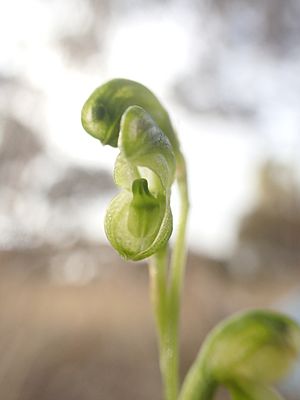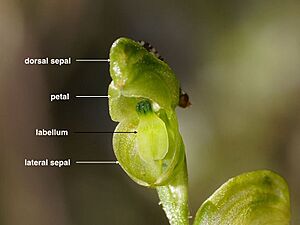Midget greenhood facts for kids
Quick facts for kids Midget greenhood |
|
|---|---|
 |
|
| Pterostylis mutica growing near Lake King, Western Australia | |
| Scientific classification | |
| Genus: |
Pterostylis
|
| Species: |
mutica
|
| Synonyms | |
|
|
The Midget greenhood (scientific name: Pterostylis mutica) is a special type of orchid plant. It grows only in Australia, found in most states but not the Northern Territory. This plant has a group of leaves at its base and can grow up to fifteen pale green flowers. These flowers have a part called a labellum that is sensitive to touch!
Contents
What is the Midget Greenhood?
The Midget greenhood is a perennial plant. This means it lives for more than two years. It is also a deciduous herb, which means its leaves fall off in certain seasons. It grows from a special underground part called a tuber.
The plant has a group of six to twelve egg-shaped leaves at its base. Each leaf is about 10 to 30 mm (0.4 to 1.2 in) long and 5 to 15 mm (0.2 to 0.6 in) wide.
Its Flowers
The Midget greenhood grows a flowering stem that can be 150 to 350 mm (6 to 14 in) tall. This stem holds between two and twenty flowers. There are also five to ten leaves wrapped around the stem.
The flowers are pale green. They are about 8 to 10 mm (0.3 to 0.4 in) long and about 5 mm (0.2 in) wide.
Flower Parts
- The dorsal sepal and petals join together to form a hood. This hood is called the "galea" and it covers the center part of the flower.
- The galea is curved and has a pointed tip that turns downwards.
- The lateral sepals (side parts) turn downwards. They are about 7 mm (0.3 in) long and 8 mm (0.3 in) wide. They are cupped and joined for most of their length.
- The labellum is about 4 mm (0.2 in) long and 2 mm (0.08 in) wide. It is whitish-green and has a dark green tip.
- Midget greenhoods usually flower from July to December.
How Did It Get Its Name?
The Midget greenhood was first officially described in 1810. A botanist named Robert Brown found a sample of the plant near Port Jackson. He wrote about it in a book called Prodromus Florae Novae Hollandiae et Insulae Van Diemen.
The scientific name mutica comes from a Latin word. It means "shortened" or "docked." This name was chosen because the petals and sepals of the flower look blunt or cut short.
Where Does It Grow?
The Midget greenhood is very common and can be found in many places across Australia. It grows in different types of environments, from near the coast to the mountains. It usually prefers soil that drains water well.
This plant is tough! It can grow in dry conditions, poor soil, and even in windy, open areas. You can find it widely in New South Wales and Victoria. It also grows in south-east Queensland, south-eastern South Australia, and the south-west of Western Australia. It's not certain if it grows in Tasmania.
How Does It Reproduce?
The Midget greenhood has a clever way to get pollinated. Its labellum (the sensitive part of the flower) attracts a type of small gnat.
When a gnat lands on the labellum and grabs its dark green tip, something amazing happens! The labellum quickly springs upwards, trapping the insect inside the flower.
To escape, the gnat has to push its way out through small "wings" on the sides of the flower's central part (called the column). As the gnat squeezes out, it either picks up pollen (called a pollinium) from the flower or leaves pollen it carried from another Midget greenhood. This process helps the orchid make seeds and reproduce.


